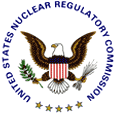| Search Options | ||||
| Index | Site Map | FAQ | Facility Info | Reading Rm | New | Help | Glossary | Contact Us | ||||

| Home > Electronic Reading Room > Document Collections > News Releases > 2008 > 08-066 |
|||||||||
 |
|
||||||||
| No. 08-066 | March 25, 2008 | ||||||||
NRC ADDS SEQUOYAH PLANT TO INITIAL SCOPE OF |
|||||||||
|
The Nuclear Regulatory Commission is adding information from the two reactors at the Sequoyah nuclear power plant to the continuing State-of-the-Art Reactor Consequence Analysis (SOARCA) project, which will be used to realistically model the outcomes of potential accidents at commercial U.S. reactors. The Tennessee Valley Authority, which operates the plant outside of Chattanooga, Tenn., volunteered to take part in the project. The staff is moving SOARCA through its first phase, which focuses on ensuring the project’s analysis methods mesh properly and have the data necessary for the most realistic results. The pressurized water reactors at Sequoyah join the project’s first two plants, the boiling water reactors at Peach Bottom in Pennsylvania, and the pressurized water reactors at Surry in Virginia, in the initial scope of the project. When this phase is completed, the Commission will provide guidance on how the staff should proceed with the remaining U.S. commercial reactors. “Having Sequoyah’s data means we can examine one more combination of reactor and containment types found in the United States,” said Farouk Eltawila, Director of the Division of Risk Assessment and Special Projects in the NRC’s Office of Nuclear Regulatory Research. “The results will help refine our methods for examining other sites.” NRC staff will gather relevant information from the plant and conduct the analysis along with contractors from Sandia National Laboratories. “Our research replaces what was done 25 years ago – studies that were so conservative that the results fell short of what’s useful for guiding public policy. Those study results have often been misused,” Eltawila said. “The advanced computers, detailed software models and vast information databases available today are in a much better position to realistically evaluate potential nuclear power plant accidents. Everyone should have a clearer understanding of the realistic consequences of such potential accidents once we’re finished.” Nuclear power plant accidents are extremely unlikely; should one occur, several layers of plant safety features and emergency procedures would mitigate most types of accidents. Nevertheless, it’s important to understand an accident’s possible consequences. SOARCA will analyze U.S. reactors, incorporating more than 25 years of research to develop realistic estimates of possible consequences resulting from a potential accident. The analyses will use site-specific weather and population data to determine how the accident might affect public health and safety. The staff will compile the analysis results and issue a public document once the entire project is complete. More information on SOARCA is available on the NRC Web site here: http://www.nrc.gov/about-nrc/regulatory/research/soar.html. |
|||||||||
|
NRC news releases are available through a free listserv subscription at the following Web address: http://www.nrc.gov/public-involve/listserver.html. The NRC Home Page at www.nrc.gov also offers a Subscribe to News link in the News & Information menu. E-mail notifications are sent to subscribers when news releases are posted to NRC's Web Site. |
|||||||||
|
Privacy Policy |
Site Disclaimer |